

The
Research Project
The Study Area
Background Information
Tools Of The Trade
A Day In The Life Of . . .
Wednesday, December 12, 2001
Conservation Lecture
Today we accompanied Lindsay to Amokwaw, a nearby village while she gave a conservation lecture to Assemblymen and Chiefs from the villages surrounding Ankasa.
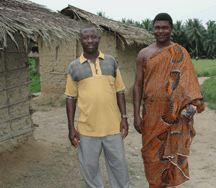 This
gathering took a good deal of prior planning. The proper authorities had
to be notified in the Wildlife Department and permissions granted. Then
everyone in the villages had to be invited in advance of the meeting. Early
this morning George and Lindsay drove to all nine or ten villages and picked
everyone up who would be attending. Finally, the meeting began around 10
AM.
This
gathering took a good deal of prior planning. The proper authorities had
to be notified in the Wildlife Department and permissions granted. Then
everyone in the villages had to be invited in advance of the meeting. Early
this morning George and Lindsay drove to all nine or ten villages and picked
everyone up who would be attending. Finally, the meeting began around 10
AM.
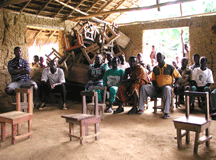 The
meeting was held in the village kindergarten classroom. Like all the village
buildings, this one was built of twelve-inch mud walls with a palm frond
roof. The floors were packed mud. While there were doorways and windows,
there were no doors that closed or glass in the windows. In the back corner
was a precarious mountain of desks and chairs reaching a good eight feet
into the air. The room was cool and comfortable.
The
meeting was held in the village kindergarten classroom. Like all the village
buildings, this one was built of twelve-inch mud walls with a palm frond
roof. The floors were packed mud. While there were doorways and windows,
there were no doors that closed or glass in the windows. In the back corner
was a precarious mountain of desks and chairs reaching a good eight feet
into the air. The room was cool and comfortable.
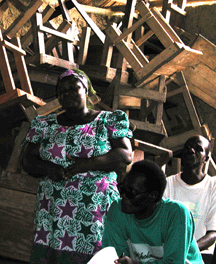 Among
the twenty or so men at the meeting was one woman dressed in beautiful traditional
cloth. Everyone simply called her the “Woman” and she appeared to be an
important member of the community. All the invited guests sat on small wooden
chairs that clearly were meant for smaller bodies. At the front of the room
was a table where Lindsay and a representative from the Wildlife Department’s
Community Development program sat. The four Chiefs sat to her right facing
the audience while we sat to the left of the table as honored guests of
the village.
Among
the twenty or so men at the meeting was one woman dressed in beautiful traditional
cloth. Everyone simply called her the “Woman” and she appeared to be an
important member of the community. All the invited guests sat on small wooden
chairs that clearly were meant for smaller bodies. At the front of the room
was a table where Lindsay and a representative from the Wildlife Department’s
Community Development program sat. The four Chiefs sat to her right facing
the audience while we sat to the left of the table as honored guests of
the village.
The Chiefs and a few other men were dressed in traditional clothing. Everyone else was in Western attire. Since many in the group did not speak English, John, standing to the side, translated for Lindsay in Twi.
Lindsay’s objective in giving this lecture (as well as the others she has given) was twofold. First she wanted to focus on educating the community in general, and the hunters among them in particular, on primate ecology. If people know more about the social structure of monkeys and their reproduction rates they will better understand the impact unrestricted hunting has on the monkey populations. Secondly, she wanted to talk to them about conservation of the Reserve and the surrounding forest buffer areas where the villages are located.
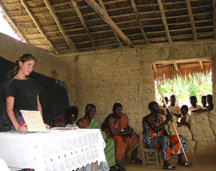 Based
on interviews Lindsay has had with hunters over the last six months, she
has found that there are common misconceptions about monkeys that lead hunters
to hunt in ways that are particularly destructive to the monkey populations
as a whole. For example, hunters may not know how few offspring a monkey
produces in its lifetime. One adult female may produce only four or five
offspring that live to maturity and reproduce. Killing one female then is
the same as killing two monkeys at least. If hunters were to limit their
take to males, the overall monkey population will remain in better standing.
Based
on interviews Lindsay has had with hunters over the last six months, she
has found that there are common misconceptions about monkeys that lead hunters
to hunt in ways that are particularly destructive to the monkey populations
as a whole. For example, hunters may not know how few offspring a monkey
produces in its lifetime. One adult female may produce only four or five
offspring that live to maturity and reproduce. Killing one female then is
the same as killing two monkeys at least. If hunters were to limit their
take to males, the overall monkey population will remain in better standing.
Lindsay wisely understands that the villagers would not be receptive to her if she merely told them not to hunt. Instead, by educating them about the monkeys, she hopes that they will hunt more wisely and responsibly. The information she gives them will help the hunters to reduce their impact on primate populations.
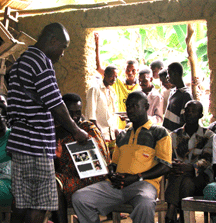 There
were three main points to her monkey ecology lecture; the range of monkeys
is limited and they don’t pass over into other monkey territories, monkeys
don’t produce many offspring in their lifetime, and killing females is like
killing two monkeys. Lindsay used an illustration to highlight the home
ranges of monkeys in relation to a hunter’s daily path. This helped the
hunters understand the ranging patterns of monkeys. She also passed out
laminated cards with photographs of the different monkey species to the
gathered group to help assist with monkey identification.
There
were three main points to her monkey ecology lecture; the range of monkeys
is limited and they don’t pass over into other monkey territories, monkeys
don’t produce many offspring in their lifetime, and killing females is like
killing two monkeys. Lindsay used an illustration to highlight the home
ranges of monkeys in relation to a hunter’s daily path. This helped the
hunters understand the ranging patterns of monkeys. She also passed out
laminated cards with photographs of the different monkey species to the
gathered group to help assist with monkey identification.
 The
second half of her lecture was about general forest conservation. The gentleman
from the Community Development Program spoke as well and they both talked
about the benefits to the villages of conservation. They discussed the possibility
of making the surrounding forest areas into a tourism area to bring greater
financial resources to the villages. Lindsay stressed that to do this however,
would take a long time and it would require the efforts of the entire community,
as everyone would have to stop hunting. If one person continued to hunt
with a gun, the animals, and the monkeys in particular, would not come around.
The
second half of her lecture was about general forest conservation. The gentleman
from the Community Development Program spoke as well and they both talked
about the benefits to the villages of conservation. They discussed the possibility
of making the surrounding forest areas into a tourism area to bring greater
financial resources to the villages. Lindsay stressed that to do this however,
would take a long time and it would require the efforts of the entire community,
as everyone would have to stop hunting. If one person continued to hunt
with a gun, the animals, and the monkeys in particular, would not come around.
As in many African cultures, the community meeting is a place where everyone gets a chance to speak their mind. At the end of Lindsay’s lecture, members of the group asked her questions. One man asked if it was indeed better to kill males than females, how could they tell them apart when it is so difficult to see anything but a shadow when hunting. Another asked what could be done about animals that come out of the forest and destroy their crops. The woman asked how could the village go about bringing tourists to the area. Through their questions, it was obvious to us that they understood the impact hunting was having and that they were searching for alternatives as well. It was also apparent that there are no simple or easy answers.
Lindsay answered all their questions and stressed the importance of not hunting at all but if they do continue to hunt, that they do so wisely and never in the closed season when the females are pregnant as killing one pregnant female monkey is the same as killing two.
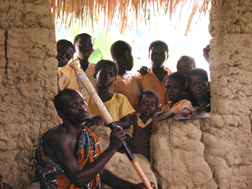 Throughout
the lecture, school children filled the windows and doorways, straining
to hear what was going on inside. Many of the children were playing and
just wanted to see why there were so many people at their village, but some
of the older ones seemed to be paying careful attention. Hopefully the lecture
struck home with them, since they will be the future protectors of the forest.
Throughout
the lecture, school children filled the windows and doorways, straining
to hear what was going on inside. Many of the children were playing and
just wanted to see why there were so many people at their village, but some
of the older ones seemed to be paying careful attention. Hopefully the lecture
struck home with them, since they will be the future protectors of the forest.
 Hunter
Interviews
Hunter
Interviews
After the lecture, we joined Lindsay while she interviewed three local hunters. The hunter interviews have been important both for determining her transects and gaining knowledge of where monkeys have been seen. From these interviews she is also able to determine how much impact hunters are having on the local wildlife.
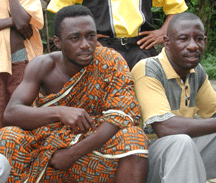 Lindsay
asked them how old they were, how long they had been hunters, whether they
used guns, traps or snares, what types of animals they hunted and what they
did with the meat. She also asked them if they had seen any monkeys, hunted
any monkeys or killed them. She asked more specific questions about the
Roloway monkeys and other endangered primates. Since there has been a bit
of a mystery about an all black monkey, she asked them if they had ever
seen one. There is no all black monkey reported to live in Ghana, but twice
Lindsay has thought she saw one and many hunters agree with her.
Lindsay
asked them how old they were, how long they had been hunters, whether they
used guns, traps or snares, what types of animals they hunted and what they
did with the meat. She also asked them if they had seen any monkeys, hunted
any monkeys or killed them. She asked more specific questions about the
Roloway monkeys and other endangered primates. Since there has been a bit
of a mystery about an all black monkey, she asked them if they had ever
seen one. There is no all black monkey reported to live in Ghana, but twice
Lindsay has thought she saw one and many hunters agree with her.
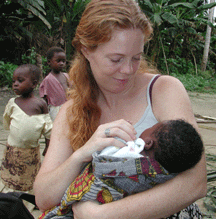 During
the interviews, we sat in the courtyard of one of the houses. There were
chickens, cats, dogs and many children who joined us. The children wanted
their pictures taken and when the camera flashed would break out into squeals
of glee. One young woman gave Shelly her baby to hold. The baby was darling,
wrapped in a blanket and sleeping. Shortly it woke up and started to fuss
for its mother.
During
the interviews, we sat in the courtyard of one of the houses. There were
chickens, cats, dogs and many children who joined us. The children wanted
their pictures taken and when the camera flashed would break out into squeals
of glee. One young woman gave Shelly her baby to hold. The baby was darling,
wrapped in a blanket and sleeping. Shortly it woke up and started to fuss
for its mother.
This afternoon, we began to pack as we are leaving tomorrow for Accra. One transect left in the early morning before we go—the last chance to see the forest as Ghanaians see it. Maybe we will be rewarded with monkeys, elephants, or other exciting wildlife ... and then again maybe we will only see tracks left in the night and shadows moving above.